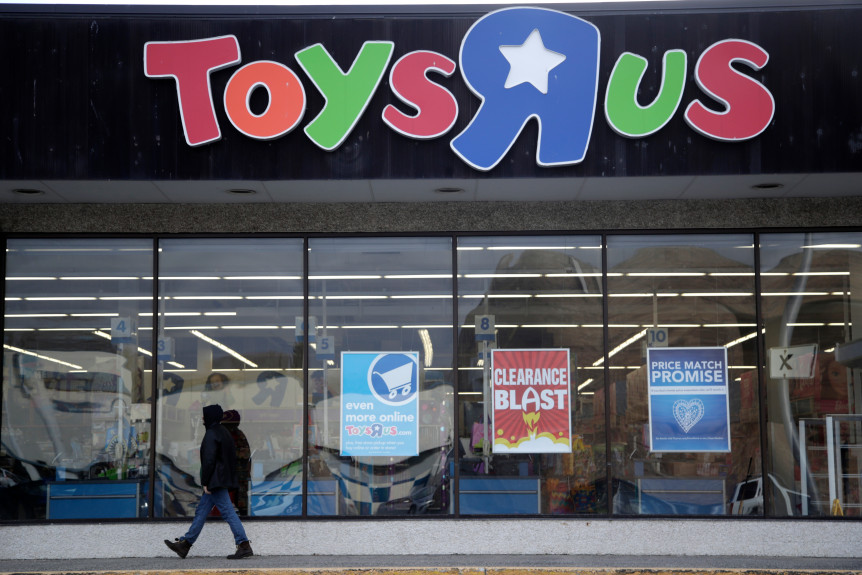
Thousands of former Toys R Us employees face an uncertain future after hundreds of stores were closed. But Geoffrey the Giraffe is back to work.
The mascot made a surprise appearance last week at one of the largest wholesale events in the toy industry. That was just days after court filings showed that the owners of Toys R Us might be pursuing a comeback, with the hedge fund that owns the company opting to hold onto the Toys R Us and Babies R Us brand names, Web domains and other assets — including Geoffrey.
A potential revamp is also coming to light through the company’s marketing. In a tweet, alongside an imagine of Geoffrey clutching a suitcase, the company said its beloved giraffe had simply been traveling the globe for a few months but was back and ready to play. On Twitter, the company said it was “actively working to bring back our iconic brands.”
To thousands of workers waiting for severance pay and even the chance to get their jobs back, Geoffrey’s fun-filled return felt more like “lemon on the wounds,” said Carrie Gleason, campaign manager for the worker advocacy group Rise Up Retail. Gleason called Geoffrey’s reemergence a “PR stunt” meant to boost the tarnished brand name should Toys R Us try to reopen stores as the holiday season gets underway.
“The employees love Geoffrey and love the brand, and so that’s what’s also insidious about this moment,” Gleason said. “They are now destroying the last thing that these toy makers and these employees have, which is the brand. They’re using it as the last way to make short-term profit.”
As Sarah Woodhams, who worked for Toys R Us for seven years, put it: “They’re saying Geoffrey went on vacation. We certainly did not go on vacation.”
There are few details that spell out how a Toys R Us revival would work, including when and how many stores might reopen. Kirkland & Ellis, debtor counsel to Toys R Us, declined to comment. The hedge fund Solus Alternative Asset Management did not respond to request for comment. The investment firm Angelo Gordon declined to comment.
In a statement, Jeffrey Pierce, chief investment officer of Snow Park Capital Partners, another Toys R Us lender, said the toy retailer’s bankruptcy created a significant void in the toy industry for consumers and the supply chain.
“But if the proposed reorganization plan moves forward, the void can be filled in a way that creates new opportunities for former employees, manufacturers and the brand,” Pierce said. “That should be the desired outcome for creditors and the company’s long-term stakeholders.”
In a separate arrangement, Bain Capital and Kohlberg Kravis Roberts — two of the three firms that bought Toys R Us in a 2005 leveraged buyout and loaded it with billions of dollars in debt before liquidating the chain in June — said they would designate millions of dollars in a fund for former employees. A third owner, Vornado Realty Trust, is not adding to the fund.
Still, details on the size of the fund are hard to come by. The Wall Street Journal reported $20 million had been set aside. Rise Up Retail says workers are owed a total of $75 million in severance pay. Before its bankruptcy, Toys R Us had guaranteed workers two weeks of severance for their first year in the job, and one week of pay for every two years of work that followed.
Toys R Us cited $7.9 billion in debt against $6.6 billion in assets when it filed for bankruptcy last year. In March, the company said it would shutter all 800 of its U.S. stores.
But the brand name itself, combined with assets like Geoffrey, still have value. Gleason said that if the company is able to shed its debt and major costs, like the legacy wages for employees, it may be able to attempt a turnaround.
“There’s a lot of people making money in this bankruptcy,” Gleason said. “And it’s just not right.”
Irving Schenkler, crisis communication at New York University’s Stern School of Business, said that generally speaking, hedge funds that run companies tend to not be closely connected with questions of corporate communication or reputation, instead putting their focus on increasing profit.
But Schenkler described a toy retailer like Toys R Us as having a “kind of halo effect” on shoppers and their childhood memories. Any rebranding that alters that emotional connection not only affects former workers, but can seep into communities where stores may reopen. The sheer optics of protests outside a new toy store, for example, would do no favors for Geoffrey’s return.
“This is a company that’s really predicated on emotion, pleasure, memory,” Schenkler said. “Things that create a dissonance, psychologically, that can affect buying patterns. You can always just go to Amazon now.” (Amazon chief executive Jeff Bezos owns The Washington Post.)
Gleason said many former employees would readily start discussions about returning to their jobs, but that there’s a fear that the owners of Toys R Us will bypass those employees in the search of low-wage labor.
Woodhams, 32, said the company is using nostalgia purely for financial gain, and that “they traded their employees in for a couple extra bucks.”
Louann Crawford, 62, is wary of returning to retail after more than 25 years with Toys R Us. But she worries about finding other prospects at her age. Around the time she lost her job with the retailer, she also lost a job working in a school cafeteria.
Now Crawford looking ahead to her first Christmas in decades without Toys R Us.
“When they said Geoffrey was coming out,” she said, “it was a kick in the gut.”






















